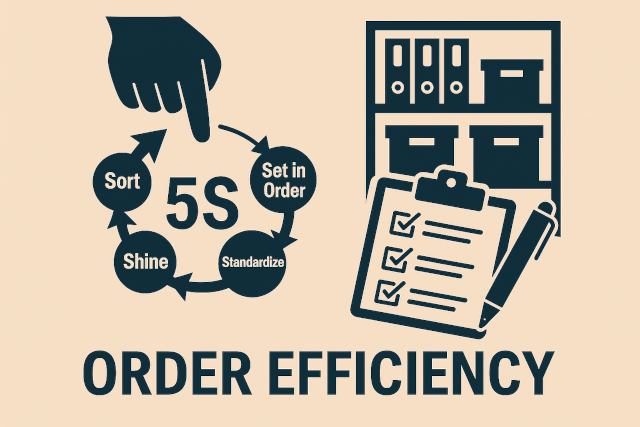Warehouses are fast-moving, high-variation environments. You’ve got:
- Thousands of SKUs
- Dozens of moving parts (literally and figuratively)
- Multiple shifts
- Complex inbound and outbound flows
- Varying levels of training and experience
Without visual management, you get confusion, errors, wasted motion, and delays. With it, you get:
- Standardized processes
- Faster onboarding and training
- Real-time problem identification
- Empowered, self-managing teams
Let’s break that down.
1. Reduces Wasted Time and Motion
When workers have to constantly ask “Where does this go?” or “What’s next?”, you’re losing productivity. Visual cues eliminate that. For example:
- A Kanban card system tells replenishment teams exactly when and what to restock.
- Colored totes can identify priority orders at a glance.
- Signs on racking can reduce hunting for storage locations.
2. Improves Accuracy
Visual job aids reduce mistakes—especially for pickers and packers. Barcode location labels, pick path maps, or part photo sheets help reduce selection errors and improve QC outcomes.
3. Makes Problems Obvious
When things go wrong, visual systems help surface the issue early. For example:
- A daily goal board with red markers shows when the team is behind on orders.
- An empty spot on a shadow board reveals a missing tool.
- Floor tape that’s worn or missing signals high-traffic areas needing review.
4. Drives Team Accountability
Visuals create ownership. When teams see their performance on a board daily—be it pick rates, order accuracy, or downtime—they engage differently. They don’t wait for a supervisor to point things out. They self-correct, collaborate, and improve together.
5. Supports Cross-Shift Consistency
Different shifts often develop their own habits. Visual management standardizes expectations and performance, so the handoff between morning and night crews stays seamless.
Practical Examples: Warehouse Visuals That Work
Here are some proven visual systems you can implement without big budgets or complicated tech:
1. Shadow Boards
- Outline tools on pegboards so missing items are instantly visible.
- Label tool names and storage order.
2. Color-Coding Systems
- Use colored bins, tags, or tape for:
- Stock status (green = OK, yellow = low, red = urgent)
- Inventory zones (picking, overstock, returns)
- Order types (standard, rush, backorder)
3. Visual Pick Paths and Maps
- Post maps near RF pick stations.
- Use aisle markers, symbols, or floor tape to guide optimal routes.
4. Performance Boards
- Post daily KPIs such as pick rates, error rates, and on-time shipments.
- Use red/yellow/green to show target performance.
- Include space for team comments or improvement suggestions.
5. Workflow Status Displays
- Use magnet boards, digital dashboards, or card holders to show:
- Orders waiting
- Orders in progress
- Orders complete
6. Floor Marking and Safety Zones
- Paint or tape walkways, forklift routes, storage areas, and hazard zones.
- Add visual reminders like “Stop—look both ways!” or “Restock here.”
7. Labeling Systems
- Barcodes on shelves and bins
- Large font location markers
- Visuals for new employees or ESL team members
How to Get Started with Visual Management
You don’t need to overhaul your whole facility overnight. Start with one zone, one team, or one visual tool. Follow these steps:
Step 1: Identify a Pain Point
Where are you seeing waste, confusion, or errors? Start there.
Step 2: Engage the Team
Ask employees what slows them down, what they forget, or what would make their job easier. Their insights will shape better visuals than a top-down guess.
Step 3: Build a Simple Visual Solution
Start low-tech: tape, laminated sheets, markers, signs, printed dashboards. Don’t wait for the perfect software or board.
Step 4: Test and Refine
Watch how the team uses it. If it’s ignored, tweak it. If it works, expand it.
Step 5: Sustain It
Assign ownership. Add it to audits. Refresh visuals monthly. Keep them relevant and up to date.
Common Mistakes to Avoid
- Over-cluttering visuals – If everything is important, nothing is.
- Using jargon-heavy signs – Keep visuals clear and simple, even for non-native speakers.
- Creating visuals no one uses – Involve the users or the system won’t stick.
- Neglecting updates – Outdated signs hurt credibility and cause confusion.
- Ignoring behavior – Visuals work best when paired with habits and accountability.
Final Thoughts: Make Your Warehouse Talk
Visual management turns your warehouse into a space that talks to the people working in it—showing them what’s needed, what’s normal, and what’s wrong. It replaces confusion with clarity, guesswork with guidance, and chaos with control.
You don’t need a big budget. You just need intention and consistency.
Start with one visual control. Then another. Over time, your warehouse becomes more intuitive, more efficient, and more team-owned—because when people can see the work, they can shape the work.
Ready to See Results in Your Warehouse?
Visual management doesn’t have to be complicated—or expensive.
It just needs to be clear, consistent, and connected to your team’s daily work.
Take the first step today:
[Download our FREE Visual Management Quick-Start Guide]
Inside, you’ll find:
- 7 proven visual management ideas you can apply this week
- Real-world warehouse examples
- A simple checklist to launch your first visual project
Your warehouse doesn’t need to shout.
It just needs to talk—and you need to listen.



